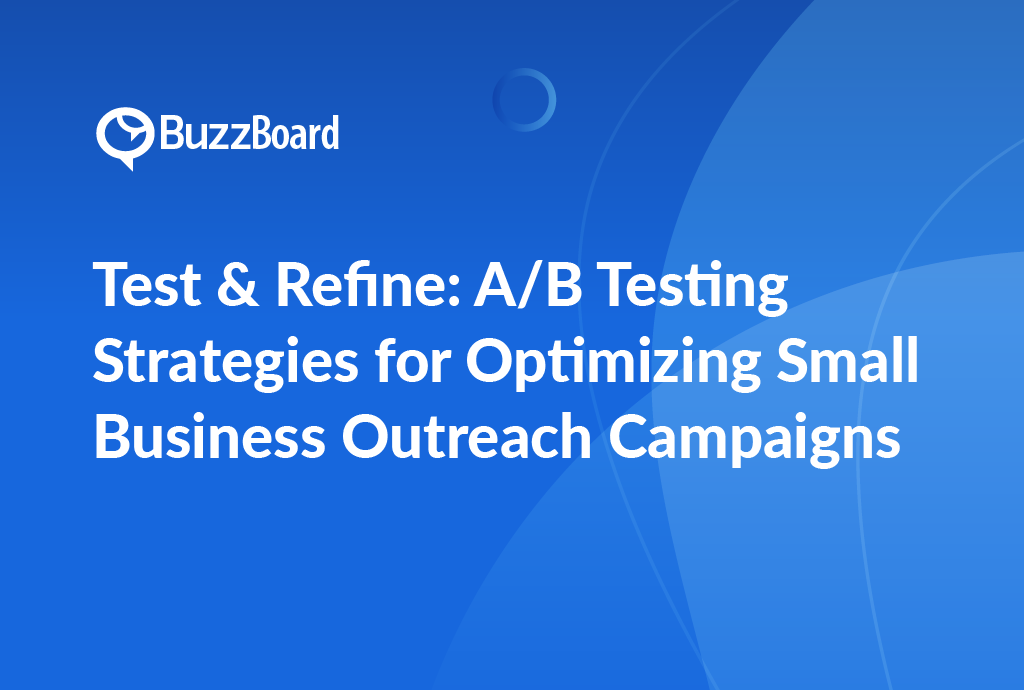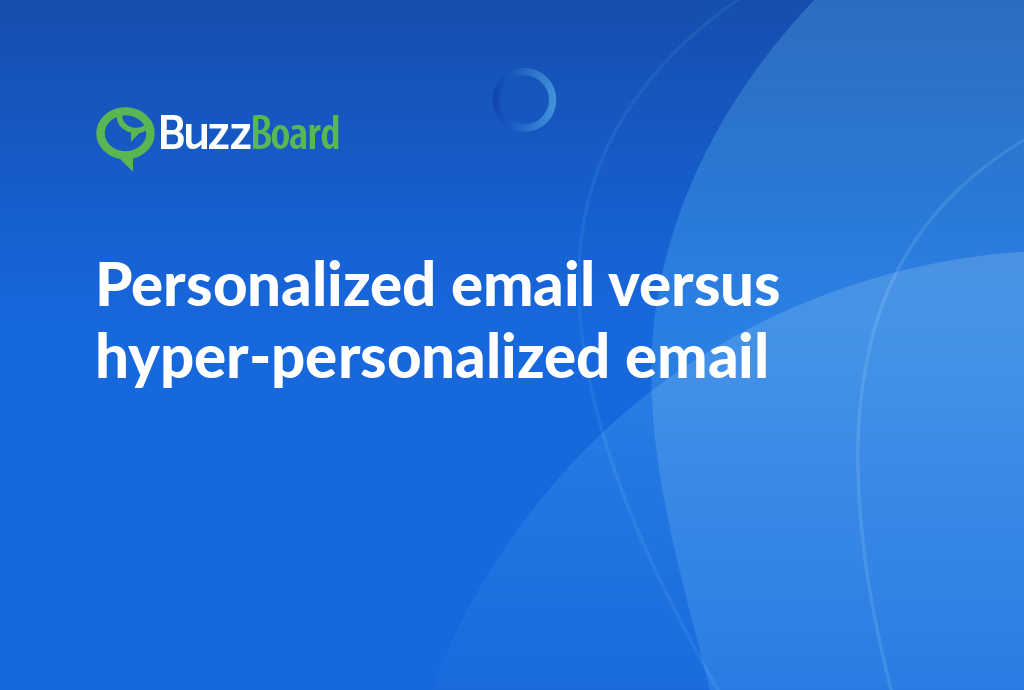What are the best A/B testing strategies for optimizing small business outreach campaigns? Learn how to test and refine your outreach efforts with BuzzBoard’s expert guide, covering topics such as email subject line optimization, landing page design, and social media ad targeting. Discover how to increase engagement, conversions, and ROI with data-driven decision making.
Introduction to A/B Testing for Small Business Outreach Campaigns
A/B testing is a valuable method that empowers you to make informed decisions regarding your outreach campaigns, thereby enhancing your return on investment and overall performance. Fundamentally, A/B testing for outreach campaigns involves crafting two renditions of a single campaign component — whether it’s the subject line, call to action, offer, landing page, or personalization factor — and examining them against each other to ascertain which performs better.
As an example, with subject line testing, you might draft two versions of an email headline to determine which one garners higher open rates. Regarding call to action testing, you can measure which phrase or button color urges more users to act. Offer testing lets you distinguish which promotional tactic appeals most to your audience, whether it’s a markdown, complimentary shipping, or a bonus with purchase.
Furthermore, landing page testing could encompass comparing design, layout, or copy variations to deduce which version engages users for a more extended period and boosts conversions. Personalization testing evaluates the efficiency of a bespoke user experience against a standard one.
Progressing further, multivariate testing provides a mechanism for carrying out simultaneous testing of numerous variables to identify the most effective amalgamation.
Integral to A/B testing is an underlying backbone of statistical analysis, facilitating drawing significant conclusions from your tests. It requires a thorough comprehension of statistical properties to evade false positives and deceptive outcomes, enriching the accuracy of your outreach campaigns.
Utilize A/B testing to transform your outreach initiatives into solid outcomes. Eager for more knowledge? Here’s an in-depth guide to A/B testing.
Understanding the Role of Different A/B Test Elements in Outreach Campaigns Such as Subject Line Testing, Call to Action Testing, Offer Testing
A/B testing has become an indispensable tool for guiding outreach strategies and optimizing campaign performance. By analyzing two versions of a marketing element, A/B testing enables marketers to identify the most effective approach, thereby enhancing the overall impact of their outreach campaigns.
One of the most critical facets of A/B testing for outreach campaigns is subject line testing. The subject line is often the first thing a recipient sees, and it can significantly influence the success of an email outreach campaign. By tweaking the subject line, marketers can enhance open rates, drive engagement, and improve conversions. For instance, testing different subject lines, such as using a question versus a statement, or incorporating humor versus a more serious tone, can help marketers determine which approach resonates best with their target audience.
Another significant aspect of A/B testing is call-to-action (CTA) testing. This process involves changing the text, color, or placement of the CTA to evaluate which version garners the most clicks. An excellent CTA is crucial for transitioning a potential customer from awareness to conversion. By testing different CTAs, such as using action-oriented language versus a more subtle approach, marketers can determine which CTA style is most effective at driving conversions.
Offer testing is another crucial task in A/B testing. Experimenting with various deals, discounts, or promotions can reveal what most entices the target audience, leading to higher conversion rates. For instance, testing different pricing structures, such as offering a free trial versus a discounted rate, can help marketers determine which approach is most appealing to their audience.
Landing page testing is another critical aspect of A/B testing. By testing different elements on the landing page, such as the headline, image, or form, marketers can enhance user experience and minimize the bounce rate. This can be achieved by testing different layouts, colors, and typography to determine which design elements resonate best with the target audience.
Personalization testing is another important aspect of A/B testing. This involves customizing messages or offers for individual users based on their behavior, demographics, or preferences. Personalization can amplify engagement and customer satisfaction by making the user feel like the message is tailored specifically to their needs. For instance, testing different subject lines or CTAs based on user behavior, such as email open rates or click-through rates, can help marketers determine which approach is most effective at engaging their target audience.
Finally, to maximize outreach efforts, consider multivariate testing. This method allows marketers to test several variables simultaneously, such as subject line, CTA, and offer, to determine which combination is most effective. Statistical analysis should then be conducted, examining the data to determine the most effective variants.
The ultimate goal of any outreach strategy is to build impactful connections with the target audience. A/B testing plays a significant role in this process, enabling marketers to fine-tune their approach for optimized outcomes. By continuously testing and refining their outreach strategies, marketers can increase engagement, drive conversions, and ultimately achieve their business goals.
By leveraging the power of A/B testing, marketers can stay ahead of the curve and achieve success in today’s competitive digital landscape.
The Importance of Landing Page and Personalization Testing in Effective Outreach Campaigns
An effective outreach campaign is built upon establishing meaningful connections with potential customers. The first point of contact is often the landing page, which is why it’s crucial to conduct thorough landing page testing to ensure this initial impression leaves a lasting and positive impact. By utilizing A/B testing for your outreach campaigns, your digital marketing team can refine the messaging, visual elements, and overall design of the landing page to optimize its performance.
Beyond optimizing the landing page, personalization testing is also a vital component of a successful outreach campaign. A recent study has demonstrated that personalized marketing campaigns can generate a significant return on investment, with a five to eight times higher ROI compared to non-personalized campaigns. Personalization enriches the customer experience, boosting the likelihood of conversion and fostering a deeper connection with potential customers.
In addition to landing page and personalization testing, subject line testing, call-to-action testing, and offer testing are also pivotal for a successful outreach campaign. Each of these elements can undergo A/B testing to identify the versions that yield the best outcomes, allowing your digital marketing team to refine and optimize their approach.
In more complex situations, multivariate testing enables the simultaneous testing of numerous changes, providing detailed insights into the performance of different variables. However, it’s essential to note that multivariate testing requires extensive statistical analysis to decipher the resulting complex data, which can be time-consuming and resource-intensive.
By applying these testing strategies, you can identify potential discrepancies in your outreach campaign, enabling you to make necessary amends and optimize its performance. This includes identifying and addressing any issues with the landing page, refining the messaging and visual elements, and optimizing the subject line, call-to-action, and offer to better resonate with your target audience.
Moreover, testing can also help you identify areas where your outreach campaign is excelling, allowing you to build upon those strengths and amplify their impact. By continually refining and optimizing your outreach campaign through testing, you can ensure that it remains effective and efficient, ultimately driving better results and a higher return on investment.
A well-planned and executed outreach campaign is built upon a foundation of testing and optimization. By leveraging A/B testing, personalization testing, subject line testing, call-to-action testing, and offer testing, you can refine and optimize your outreach campaign to better resonate with your target audience, drive better results, and ultimately achieve your marketing goals.
Exploring the Complexity of Multivariate Testing and Its Significance in A/B Testing
Understanding the intricacies of multivariate testing has become a crucial aspect of successful outreach campaigns. This advanced testing methodology is particularly significant when used in conjunction with A/B testing, as it enables marketers to gain a deeper understanding of how various elements interact and influence visitor behavior.
Multivariate testing is an extension of A/B testing, which typically involves comparing two versions of a webpage to determine which one performs better. In contrast, multivariate testing allows marketers to simultaneously evaluate multiple variables on a single webpage, providing a comprehensive statistical analysis of which combinations are most effective. This approach enables businesses to make informed, data-centric decisions about their marketing strategies, rather than relying on intuition or guesswork.
When it comes to outreach campaigns, multivariate testing can be applied to a wide range of variables, including subject line testing, call-to-action testing, landing page testing, and personalization testing. By testing these variables in combination, marketers can gain a better understanding of how individual elements co-work and influence visitor behavior. For instance, a marketer may test different subject lines, calls-to-action, and landing pages to determine which combination yields the highest conversion rates.
The benefits of multivariate testing are numerous. By eliminating guesswork and providing a data-driven approach to marketing, businesses can optimize every detail of their outreach campaigns, from the email subject line to the landing page. This ensures that every element of the campaign is designed to captivate and engage the target audience, ultimately driving conversions and revenue.
One of the key advantages of multivariate testing is its ability to provide a more individualized user experience. By testing different variables and combinations, marketers can identify which elements resonate most with their target audience, and tailor their campaigns accordingly. This personalized approach can lead to higher engagement rates, increased conversions, and a more loyal customer base.
In addition to its benefits, multivariate testing also offers a range of practical applications. For example, marketers can use multivariate testing to:
- Optimize email campaigns by testing subject lines, calls-to-action, and landing pages
- Improve website conversions by testing different layouts, colors, and CTAs
- Enhance social media campaigns by testing different ad creative, targeting options, and messaging
- Refine content marketing strategies by testing different formats, lengths, and topics
By incorporating multivariate testing into their marketing strategies, businesses can gain a competitive edge and drive real results. Whether you’re looking to improve email open rates, increase website conversions, or enhance customer engagement, multivariate testing can help you achieve your goals and stay ahead of the competition.
The Role of Statistical Analysis in Interpreting A/B Test Results and Refining Outreach Strategies
Gaining a competitive edge is crucial for success. One of the most effective ways to achieve this is by leveraging the power of statistical analysis, a critical tool that enables marketers to interpret A/B test results and fine-tune their outreach strategies with precision.
A/B testing, also known as split testing, is a popular strategy in digital marketing where two or more versions of a campaign are simultaneously launched to different audience segments. These campaigns can vary on numerous variables, such as subject line testing, call-to-action testing, offer testing, landing page testing, personalization testing, and more. The campaign that yields the most positive results ultimately prevails, and the accurate determination of the winning campaign relies heavily on comprehensive statistical analysis of data points and metrics gathered from these campaigns.
For instance, multivariate testing, a method for assessing the performance of different elements in a campaign simultaneously, greatly benefits from the use of statistical analysis. By leveraging this tool, organizations can uncover alternative strategies that yield maximum conversions, and make data-driven decisions that drive real results.
Moreover, statistical analysis allows marketers to look beyond standard metrics, such as Click-Through-Rates (CTR) and conversion rates, and delve deeper into more insightful data. It enables the assessment of long-term values, churn rates, and other vital factors that can significantly influence a campaign’s success. By analyzing these metrics, marketers can identify areas of improvement and optimize their campaigns for better performance.
The objective of statistical analysis in A/B testing is to glean actionable insights that assist in developing outreach strategies that resonate with the target audience and meet all necessary criteria. It’s not just about taking a shot in the dark and hoping for the best – it’s about making data-driven decisions powered by exhaustive statistical analysis.
In today’s digital landscape, where data is king, statistical analysis is no longer a luxury, but a necessity. By exploiting the power of statistical analysis, marketers can gain a deeper understanding of their audience, optimize their campaigns for better performance, and drive real results. Whether you’re looking to improve conversion rates, increase engagement, or enhance customer satisfaction, statistical analysis is the key to unlocking your marketing potential.
Statistical analysis is a critical component of A/B testing, and its importance cannot be overstated. By leveraging the power of statistical analysis, marketers can gain a competitive edge, optimize their campaigns for better performance, and drive real results. So, if you’re looking to take your marketing efforts to the next level, it’s time to exploit the power of statistical analysis today and start making data-driven decisions that drive real results.
Conclusion
In conclusion, A/B testing is a powerful tool for small business owners looking to optimize their outreach campaigns and drive real results. By testing and refining various elements of their campaigns, businesses can increase engagement, conversions, and ultimately, revenue. From email subject lines to landing page design, and from social media ad targeting to follow-up email sequences, there are countless opportunities to test and improve.
By following the strategies outlined in this article, small business owners can ensure that their outreach campaigns are effective, efficient, and tailored to their target audience. Remember to keep your tests focused, your data organized, and your analysis clear, and you’ll be well on your way to achieving your marketing goals.
Whether you’re just starting out or looking to take your marketing efforts to the next level, A/B testing is an essential tool for any small business owner. So why not get started today? Identify your goals, design your tests, and start optimizing your outreach campaigns for maximum impact. With the right approach and the right tools, the possibilities are endless.









